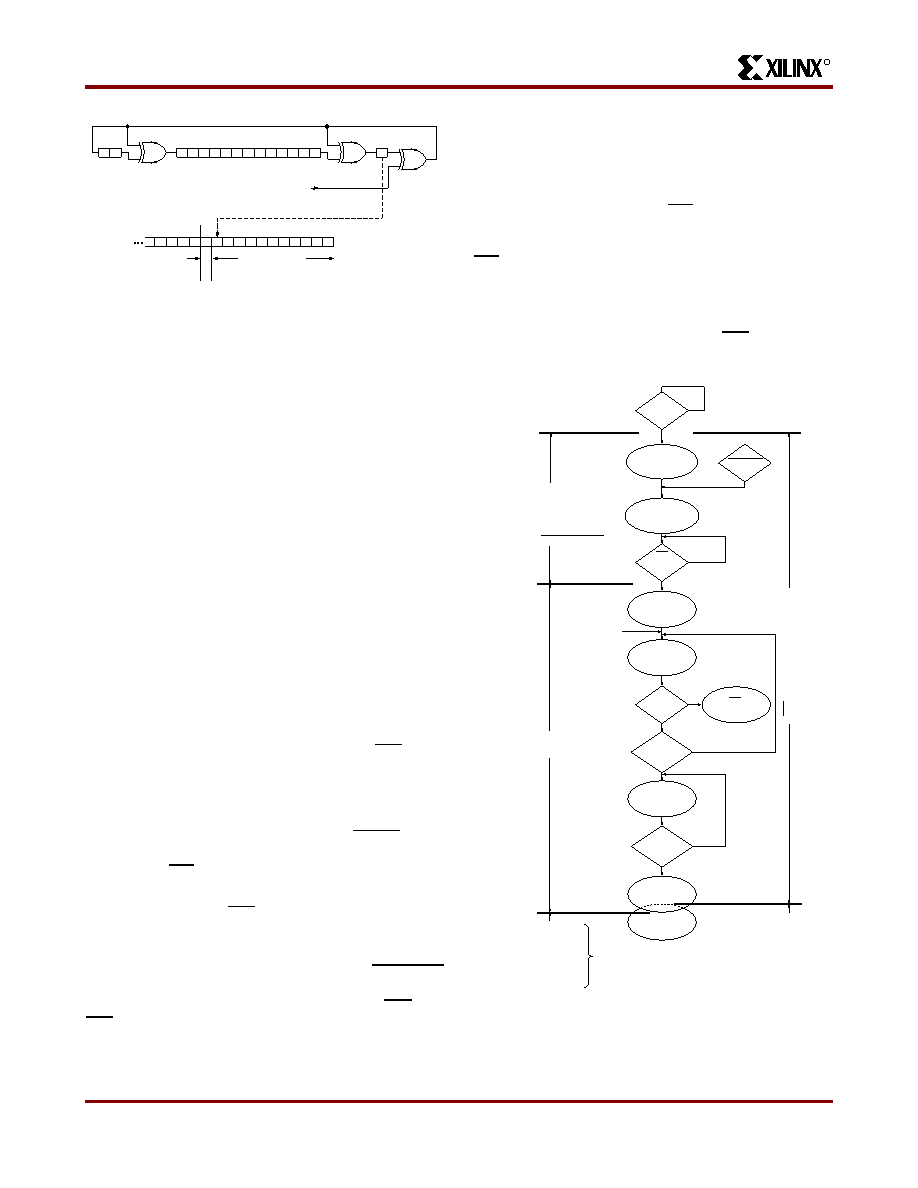- 您現(xiàn)在的位置:買賣IC網(wǎng) > PDF目錄4174 > XC5206-5TQ144C (Xilinx Inc)IC FPGA 196 CLB'S 144-TQFP PDF資料下載
參數(shù)資料
| 型號: | XC5206-5TQ144C |
| 廠商: | Xilinx Inc |
| 文件頁數(shù): | 19/73頁 |
| 文件大小: | 0K |
| 描述: | IC FPGA 196 CLB'S 144-TQFP |
| 產(chǎn)品變化通告: | XC1700 PROMs,XC5200,HQ,SCD Parts Discontinuation 19/Jul/2010 |
| 標(biāo)準(zhǔn)包裝: | 60 |
| 系列: | XC5200 |
| LAB/CLB數(shù): | 196 |
| 邏輯元件/單元數(shù): | 784 |
| 輸入/輸出數(shù): | 117 |
| 門數(shù): | 10000 |
| 電源電壓: | 4.75 V ~ 5.25 V |
| 安裝類型: | 表面貼裝 |
| 工作溫度: | 0°C ~ 85°C |
| 封裝/外殼: | 144-LQFP |
| 供應(yīng)商設(shè)備封裝: | 144-TQFP(20x20) |
| 其它名稱: | 122-1143 |
第1頁第2頁第3頁第4頁第5頁第6頁第7頁第8頁第9頁第10頁第11頁第12頁第13頁第14頁第15頁第16頁第17頁第18頁當(dāng)前第19頁第20頁第21頁第22頁第23頁第24頁第25頁第26頁第27頁第28頁第29頁第30頁第31頁第32頁第33頁第34頁第35頁第36頁第37頁第38頁第39頁第40頁第41頁第42頁第43頁第44頁第45頁第46頁第47頁第48頁第49頁第50頁第51頁第52頁第53頁第54頁第55頁第56頁第57頁第58頁第59頁第60頁第61頁第62頁第63頁第64頁第65頁第66頁第67頁第68頁第69頁第70頁第71頁第72頁第73頁

R
XC5200 Series Field Programmable Gate Arrays
7-108
November 5, 1998 (Version 5.2)
Configuration Sequence
There are four major steps in the XC5200-Series power-up
configuration sequence.
Power-On Time-Out
Initialization
Configuration
Start-Up
The full process is illustrated in Figure 24.
Power-On Time-Out
An internal power-on reset circuit is triggered when power
is applied. When V
CC reaches the voltage at which portions
of
the
FPGA
begin
to
operate
(i.e.,
performs
a
write-and-read test of a sample pair of configuration mem-
ory bits), the programmable I/O buffers are 3-stated with
active high-impedance pull-up resistors. A time-out delay
— nominally 4 ms — is initiated to allow the power-supply
voltage to stabilize. For correct operation the power supply
must reach V
CC(min) by the end of the time-out, and must
not dip below it thereafter.
There is no distinction between master and slave modes
with regard to the time-out delay. Instead, the INIT line is
used to ensure that all daisy-chained devices have com-
pleted initialization. Since XC2000 devices do not have this
signal, extra care must be taken to guarantee proper oper-
ation when daisy-chaining them with XC5200 devices. For
proper operation with XC3000 devices, the RESET signal,
which is used in XC3000 to delay configuration, should be
connected to INIT.
If the time-out delay is insufficient, configuration should be
delayed by holding the INIT pin Low until the power supply
has reached operating levels.
This delay is applied only on power-up. It is not applied
when reconfiguring an FPGA by pulsing the PROGRAM
pin Low. During all three phases — Power-on, Initialization,
and Configuration — DONE is held Low; HDC, LDC, and
INIT are active; DOUT is driven; and all I/O buffers are dis-
abled.
Initialization
This phase clears the configuration memory and estab-
lishes the configuration mode.
The configuration memory is cleared at the rate of one
frame per internal clock cycle (nominally 1 MHz). An
open-drain bidirectional signal, INIT, is released when the
configuration memory is completely cleared. The device
then tests for the absence of an external active-low level on
INIT. The mode lines are sampled two internal clock cycles
later (nominally 2
s).
The master device waits an additional 32
s to 256 s
(nominally 64-128
s) to provide adequate time for all of the
slave devices to recognize the release of INIT as well. Then
the master device enters the Configuration phase.
0
X2
2
3456789 10 11 12 13 14
1
X15
X16
15
SERIAL DATA IN
1
0 1514 13 12 1110 9
8
7
65
1
CRC – CHECKSUM
LAST DATA FRAME
START
BIT
X1789
Polynomial: X16 + X15 + X2 + 1
Readback Data Stream
Figure 23: Circuit for Generating CRC-16
Figure 24: Configuration Sequence
INIT
High? if
Master
Sample
Mode Lines
Load One
Configuration
Data Frame
Frame
Error
Pass
Configuration
Data to DOUT
VCC
3V
No
Yes
No
Yes
Operational
Start-Up
Sequence
No
Yes
~1.3
s per Frame
Master CCLK
Goes Active after
50 to 250
s
F
Pull INIT Low
and Stop
X9017
EXTEST*
SAMPLE/PRELOAD*
BYPASS
CONFIGURE*
(*only when PROGRAM = High)
SAMPLE/PRELOAD
BYPASS
EXTEST
SAMPLE PRELOAD
BYPASS
USER 1
USER 2
CONFIGURE
READBACK
If Boundary Scan
is Selected
Config-
uration
memory
Full
CCLK
Count Equals
Length
Count
Completely Clear
Configuration
Memory
LDC
Output
=
L,
HDC
Output
=
H
Boundary Scan
Instructions
Available:
I/O
Active
Generate
One Time-Out Pulse
of 4 ms
PROGRAM
= Low
No
Yes
Product Obsolete or Under Obsolescence
相關(guān)PDF資料 |
PDF描述 |
|---|---|
| ABB105DHRR | CONN CARD EXTEND 210POS .050" |
| XC5206-5PQ208C | IC FPGA 196 CLB'S 208-PQFP |
| ABB65DHAS | CONN EDGECARD 130PS R/A .050 SLD |
| XC5206-6PQ160C | IC FPGA 196 CLB'S 160-PQFP |
| GSC49DTEI | CONN EDGECARD 98POS .100 EYELET |
相關(guān)代理商/技術(shù)參數(shù) |
參數(shù)描述 |
|---|---|
| XC5206-5TQ144C0262 | 制造商:Xilinx 功能描述: |
| XC5206-5TQ144I | 制造商:未知廠家 制造商全稱:未知廠家 功能描述:Field Programmable Gate Array (FPGA) |
| XC5206-5TQ176C | 制造商:Xilinx 功能描述: 制造商:Xilinx 功能描述:FPGA, 196 CLBS, 6000 GATES, 83 MHz, PQFP176 |
| XC5206-5VQ100C | 制造商:Xilinx 功能描述: |
| XC5206-5VQ100I | 制造商:未知廠家 制造商全稱:未知廠家 功能描述:Field Programmable Gate Array (FPGA) |
發(fā)布緊急采購,3分鐘左右您將得到回復(fù)。